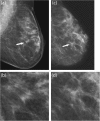X-ray phase-contrast imaging of the breast--advances towards clinical implementation
- PMID: 24452106
- PMCID: PMC4064551
- DOI: 10.1259/bjr.20130606
X-ray phase-contrast imaging of the breast--advances towards clinical implementation
Abstract
Breast cancer constitutes about one-quarter of all cancers and is the leading cause of cancer death in women. To reduce breast cancer mortality, mammographic screening programmes have been implemented in many Western countries. However, these programmes remain controversial because of the associated radiation exposure and the need for improvement in terms of diagnostic accuracy. Phase-contrast imaging is a new X-ray-based technology that has been shown to provide enhanced soft-tissue contrast and improved visualization of cancerous structures. Furthermore, there is some indication that these improvements of image quality can be maintained at reduced radiation doses. Thus, X-ray phase-contrast mammography may significantly contribute to advancements in early breast cancer diagnosis. Feasibility studies of X-ray phase-contrast breast CT have provided images that allow resolution of the fine structure of tissue that can otherwise only be obtained by histology. This implies that X-ray phase-contrast imaging may also lead to the development of entirely new (micro-) radiological applications. This review provides a brief overview of the physical characteristics of this new technology and describes recent developments towards clinical implementation of X-ray phase-contrast imaging of the breast.
Figures

 , where δ is proportional to the phase shift and iβ is proportional to absorption. For biological tissues and the X-ray energies typically used in breast imaging, δ is significantly larger than iβ.
, where δ is proportional to the phase shift and iβ is proportional to absorption. For biological tissues and the X-ray energies typically used in breast imaging, δ is significantly larger than iβ.



Similar articles
-
[Phase contrast imaging of the breast. Basic principles and steps towards clinical implementation].Radiologe. 2014 Mar;54(3):254-61. doi: 10.1007/s00117-013-2577-3. Radiologe. 2014. PMID: 24623010 Review. German.
-
X-Ray Phase-Contrast Technology in Breast Imaging: Principles, Options, and Clinical Application.AJR Am J Roentgenol. 2018 Jul;211(1):133-145. doi: 10.2214/AJR.17.19179. Epub 2018 May 24. AJR Am J Roentgenol. 2018. PMID: 29792739 Review.
-
Low dose high energy x-ray in-line phase sensitive imaging prototype: Investigation of optimal geometric conditions and design parameters.J Xray Sci Technol. 2015;23(6):667-82. doi: 10.3233/XST-150519. J Xray Sci Technol. 2015. PMID: 26756405 Free PMC article.
-
X-ray phase-contrast tomosynthesis for improved breast tissue discrimination.Eur J Radiol. 2014 Mar;83(3):531-6. doi: 10.1016/j.ejrad.2013.12.005. Epub 2013 Dec 12. Eur J Radiol. 2014. PMID: 24387825
-
Strategies to Increase Cancer Detection: Review of True-Positive and False-Negative Results at Digital Breast Tomosynthesis Screening.Radiographics. 2016 Nov-Dec;36(7):1954-1965. doi: 10.1148/rg.2016160049. Epub 2016 Oct 7. Radiographics. 2016. PMID: 27715711 Free PMC article. Review.
Cited by
-
Phosphotungstic acid-enhanced microcomputed tomography for quantitative visualization of mouse mammary gland morphology.J Med Imaging (Bellingham). 2023 Feb;10(Suppl 2):S22402. doi: 10.1117/1.JMI.10.S2.S22402. Epub 2023 Feb 21. J Med Imaging (Bellingham). 2023. PMID: 36825256 Free PMC article.
-
Simultaneous wood and metal particle detection on dark-field radiography.Eur Radiol Exp. 2018;2(1):1. doi: 10.1186/s41747-017-0034-1. Epub 2018 Jan 10. Eur Radiol Exp. 2018. PMID: 29708215 Free PMC article.
-
Visualizing typical features of breast fibroadenomas using phase-contrast CT: an ex-vivo study.PLoS One. 2014 May 13;9(5):e97101. doi: 10.1371/journal.pone.0097101. eCollection 2014. PLoS One. 2014. PMID: 24824169 Free PMC article.
-
Dedicated breast CT: state of the art-Part I. Historical evolution and technical aspects.Eur Radiol. 2022 Mar;32(3):1579-1589. doi: 10.1007/s00330-021-08179-z. Epub 2021 Aug 3. Eur Radiol. 2022. PMID: 34342694 Review.
-
Large-angle x-ray scatter in Talbot-Lau interferometry for breast imaging.Phys Med Biol. 2014 Nov 7;59(21):6387-400. doi: 10.1088/0031-9155/59/21/6387. Epub 2014 Oct 8. Phys Med Biol. 2014. PMID: 25295630 Free PMC article.
References
-
- GLOBOCAN. Cancer fact sheets: breast cancer. Lyons, France: International Agency for Research on Cancer; 2012. Available from:http://globocan.iarc.fr/pages/fact_sheets_cancer.aspx
-
- National Cancer Institute Surveillance epidemiology and end results (SEER) stat fact sheets: breast cancer. 2009. Bethesda, MD: NCI; 2012. Available from: http://seer.cancer.gov/statfacts/html/breast.html
Publication types
MeSH terms
LinkOut - more resources
Full Text Sources
Other Literature Sources
Medical

